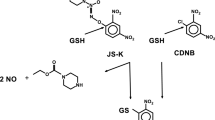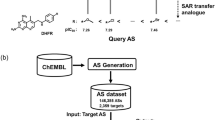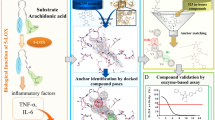Abstract
Nitric oxide synthase (NOS) enzymes synthesize nitric oxide, a signal for vasodilatation and neurotransmission at low concentrations and a defensive cytotoxin at higher concentrations. The high active site conservation among all three NOS isozymes hinders the design of selective NOS inhibitors to treat inflammation, arthritis, stroke, septic shock and cancer. Our crystal structures and mutagenesis results identified an isozyme-specific induced-fit binding mode linking a cascade of conformational changes to a new specificity pocket. Plasticity of an isozyme-specific triad of distant second- and third-shell residues modulates conformational changes of invariant first-shell residues to determine inhibitor selectivity. To design potent and selective NOS inhibitors, we developed the anchored plasticity approach: anchor an inhibitor core in a conserved binding pocket, then extend rigid bulky substituents toward remote specificity pockets, which become accessible upon conformational changes of flexible residues. This approach exemplifies general principles for the design of selective enzyme inhibitors that overcome strong active site conservation.
This is a preview of subscription content, access via your institution
Access options
Subscribe to this journal
Receive 12 print issues and online access
$259.00 per year
only $21.58 per issue
Buy this article
- Purchase on Springer Link
- Instant access to full article PDF
Prices may be subject to local taxes which are calculated during checkout





Similar content being viewed by others
References
Geller, D.A. & Billiar, T.R. Molecular biology of nitric oxide synthases. Cancer Metastasis Rev. 17, 7–23 (1998).
Nathan, C. The moving frontier in nitric oxide-dependent signaling. Sci. STKE 2004, pe52 (2004).
Bian, K. & Murad, F. Nitric oxide (NO)–biogeneration, regulation, and relevance to human diseases. Front. Biosci. 8, d264–d278 (2003).
Thippeswamy, T., McKay, J.S., Quinn, J.P. & Morris, R. Nitric oxide, a biological double-faced Janus–is this good or bad? Histol. Histopathol. 21, 445–458 (2006).
Duncan, A.J. & Heales, S.J. Nitric oxide and neurological disorders. Mol. Aspects Med. 26, 67–96 (2005).
Crane, B.R. et al. The structure of nitric oxide synthase oxygenase domain and inhibitor complexes. Science 278, 425–431 (1997).
Crane, B.R. et al. Structure of nitric oxide synthase oxygenase dimer with pterin and substrate. Science 279, 2121–2126 (1998).
Raman, C.S. et al. Crystal structure of constitutive endothelial nitric oxide synthase: a paradigm for pterin function involving a novel metal center. Cell 95, 939–950 (1998).
Crane, B.R. et al. N-terminal domain swapping and metal ion binding in nitric oxide synthase dimerization. EMBO J. 18, 6271–6281 (1999).
Fischmann, T.O. et al. Structural characterization of nitric oxide synthase isoforms reveals striking active-site conservation. Nat. Struct. Biol. 6, 233–242 (1999).
Crane, B.R. et al. Structures of the N(omega)-hydroxy-L-arginine complex of inducible nitric oxide synthase oxygenase dimer with active and inactive pterins. Biochemistry 39, 4608–4621 (2000).
Rosenfeld, R.J. et al. Conformational changes in nitric oxide synthases induced by chlorzoxazone and nitroindazoles: crystallographic and computational analyses of inhibitor potency. Biochemistry 41, 13915–13925 (2002).
Fedorov, R., Hartmann, E., Ghosh, D.K. & Schlichting, I. Structural basis for the specificity of the nitric-oxide synthase inhibitors W1400 and N\{omega\}-propyl-L-Arg for the inducible and neuronal isoforms. J. Biol. Chem. 278, 45818–45825 (2003).
Flinspach, M. et al. Structural basis for dipeptide amide isoform-selective inhibition of neuronal nitric oxide synthase. Nat. Struct. Mol. Biol. 11, 54–59 (2004).
Flinspach, M. et al. Structures of the neuronal and endothelial nitric oxide synthase heme domain with D-nitroarginine-containing dipeptide inhibitors bound. Biochemistry 43, 5181–5187 (2004).
Aoyagi, M., Arvai, A.S., Tainer, J.A. & Getzoff, E.D. Structural basis for endothelial nitric oxide synthase binding to calmodulin. EMBO J. 22, 766–775 (2003).
Abu-Soud, H.M. & Stuehr, D.J. Nitric oxide synthases reveal a role for calmodulin in controlling electron transfer. Proc. Natl. Acad. Sci. USA 90, 10769–10772 (1993).
Zhang, J. et al. Crystal structure of the FAD/NADPH-binding domain of rat neuronal nitric-oxide synthase. Comparisons with NADPH-cytochrome P450 oxidoreductase. J. Biol. Chem. 276, 37506–37513 (2001).
Garcin, E.D. et al. Structural basis for isozyme-specific regulation of electron transfer in nitric oxide synthase. J. Biol. Chem. 279, 37918–37927 (2004).
Ji, H., Li, H., Flinspach, M., Poulos, T.L. & Silverman, R.B. Computer modeling of selective regions in the active site of nitric oxide synthases: implication for the design of isoform-selective inhibitors. J. Med. Chem. 46, 5700–5711 (2003).
Li, H. & Poulos, T.L. Structure-function studies on nitric oxide synthases. J. Inorg. Biochem. 99, 293–305 (2005).
Zhu, Y., Nikolic, D., VanBreemen, R.B. & Silverman, R.B. Mechanism of inactivation of inducible nitric oxide synthase by amidines. Irreversible enzyme inactivation without inactivator modification. J. Am. Chem. Soc. 127, 858–868 (2005).
Strub, A. et al. The novel imidazopyridine 2-[2-(4-methoxy-pyridin-2-yl)-ethyl]-3H-imidazo[4,5-b]pyridine (BYK191023) is a highly selective inhibitor of the inducible nitric-oxide synthase. Mol. Pharmacol. 69, 328–337 (2006).
Tafi, A. et al. Computational studies of competitive inhibitors of nitric oxide synthase (NOS) enzymes: towards the development of powerful and isoform-selective inhibitors. Curr. Med. Chem. 13, 1929–1946 (2006).
Tinker, A. & Wallace, A.V. Selective inhibitors of inducible nitric oxide synthase: potential agents for the treatment of inflammatory diseases? Curr. Top. Med. Chem. 6, 77–92 (2006).
Tinker, A.C. et al. 1,2-dihydro-4-quinazolinamine: potent, highly selective inhibitors of inducible nitric oxide synthase which show antiinflammatory activity in vivo. J. Med. Chem. 46, 913–916 (2003).
Hagmann, W.K. et al. Substituted 2-aminopyridines as inhibitors of nitric oxide synthases. Bioorg. Med. Chem. Lett. 10, 1975–1978 (2000).
Connolly, S. et al. 2-aminopyridines as highly-selective inducible nitric oxide synthase inhibitors. Differential binding modes dependent on nitrogen substitution. J. Med. Chem. 47, 3320–3323 (2004).
Sandstrom, P. et al. Highly selective inhibition of inducible nitric oxide synthase ameliorates experimental acute pancreatitis. Pancreas 30, e10–e15 (2005).
LaBuda, C.J., Koblish, M., Tuthill, P., Dolle, R.E. & Little, P.J. Antinociceptive activity of the selective iNOS inhibitor AR-C102222 in rodent models of inflammatory, neuropathic and post-operative pain. Eur. J. Pain 10, 505–512 (2006).
Gachhui, R. et al. Mutagenesis of acidic residues in the oxygenase domain of inducible nitric-oxide synthase identifies a glutamate involved in arginine binding. Biochemistry 36, 5097–5103 (1997).
Connolly, S. & Cox, D. Compounds. WO patent WO2000021934 (2000).
Li, H. et al. Exploring the binding conformations of bulkier dipeptide amide inhibitors in constitutive nitric oxide synthases. Biochemistry 44, 15222–15229 (2005).
Ji, H. et al. Minimal pharmacophoric elements and fragment hopping, an approach directed at molecular diversity and isozyme selectivity. Design of selective neuronal nitric oxide synthase inhibitors. J. Am. Chem. Soc. 130, 3900–3914 (2008).
Cheshire, D. et al. 5,7-bicyclic amidine derivatives useful as nitric oxide synthase inhibitors. WO patent WO2000064904 (2000).
Sluis-Cremer, N., Temiz, N.A. & Bahar, I. Conformational changes in HIV-1 reverse transcriptase induced by nonnucleoside reverse transcriptase inhibitor binding. Curr. HIV Res. 2, 323–332 (2004).
Urzhumtsev, A. et al. A 'specificity' pocket inferred from the crystal structures of the complexes of aldose reductase with the pharmaceutically important inhibitors tolrestat and sorbinil. Structure 5, 601–612 (1997).
Kurumbail, R.G. et al. Structural basis for selective inhibition of cyclooxygenase-2 by anti-inflammatory agents. Nature 384, 644–648 (1996).
Garavito, R.M. & Mulichak, A.M. The structure of mammalian cyclooxygenases. Annu. Rev. Biophys. Biomol. Struct. 32, 183–206 (2003).
Liu, Y. & Gray, N.S. Rational design of inhibitors that bind to inactive kinase conformations. Nat. Chem. Biol. 2, 358–364 (2006).
James, L.C., Roversi, P. & Tawfik, D.S. Antibody multispecificity mediated by conformational diversity. Science 299, 1362–1367 (2003).
Ghosh, D.K. et al. Characterization of the inducible nitric oxide synthase oxygenase domain identifies a 49 amino acid segment required for subunit dimerization and tetrahydrobiopterin interaction. Biochemistry 36, 10609–10619 (1997).
Martasek, P. et al. Characterization of bovine endothelial nitric oxide synthase expressed in E. coli. Biochem. Biophys. Res. Commun. 219, 359–365 (1996).
Sherman, P.A., Laubach, V.E., Reep, B.R. & Wood, E.R. Purification and cDNA sequence of an inducible nitric oxide synthase from a human tumor cell line. Biochemistry 32, 11600–11605 (1993).
Otwinowski, Z. & Minor, W. Processing of X-ray diffraction data collected in oscillation mode. Methods Enzymol. 276, 307–326 (1997).
Navaza, J. AMoRe: an automated package for molecular replacement. Acta Crystallogr. A 50, 157–163 (1994).
Kleywegt, G.J. & Jones, T.A. Databases in protein crystallography. Acta Crystallogr. D Biol. Crystallogr. 54, 1119–1131 (1998).
Kleywegt, G.J., Henrick, K., Dodson, E.J. & van Aalten, D.M.F. Pound-wise but penny-foolish. How well do micromolecules fare in macromolecular refinement? Structure 11, 1051–1059 (2003).
Read, R.J. Improved Fourier coefficients for maps using phases from partial structures with errors. Acta Crystallogr. A 42, 140–149 (1986).
Brünger, A.T. et al. Crystallography & NMR system: a new software suite for macromolecular structure determination. Acta Crystallogr. D Biol. Crystallogr. 54, 905–921 (1998).
Jones, T.A., Zou, J.-Y., Cowan, S.W. & Kjeldgaard, M. Improved methods for building protein models in electron density maps and the location of errors in these models. Acta Crystallogr. A 47, 110–119 (1991).
McRee, D.E. XtalView/Xfit - a versatile program for manipulating atomic coordinates and electron density. J. Struct. Biol. 125, 156–165 (1999).
Emsley, P. & Cowtan, K. Coot: model-building tools for molecular graphics. Acta Crystallogr. D Biol. Crystallogr. 60, 2126–2132 (2004).
Collaborative Computational Project, Number 4. The CCP4 suite: programs for protein crystallography. Acta Crystallogr. D Biol. Crystallogr. 50, 760–763 (1994).
Acknowledgements
We thank K. Panda (Cleveland Clinic) and S. Ghosh (Cleveland Clinic) for preparation of the mouse iNOSox and bovine eNOSox proteins used in this study. Part of this work is based on research conducted at CHESS, SSRL, ESRF and MAX-LAB (Lund University). This work was supported in part by US National Institutes of Health grants (E.D.Getzoff and D.J.S.), and by the Skaggs Institute for Chemical Biology (E.D.Garcin).
Author information
Authors and Affiliations
Contributions
E.D.Garcin, crystallization, X-ray data collection and refinement, mutant design, binding assays, interpretation of structural and biochemical results, and preparation of figures and manuscript. A.S.A., crystallization, X-ray data collection and refinement. R.J.R., crystallization, X-ray data collection and refinement, and interpretation of structural results. M.D.K., mutagenesis, expression and purification of double mutant protein, binding assay and crystallization. B.R.C., crystallization, X-ray data collection and refinement. G.Andersson and A.Å., cloning, expression and purification of human iNOSox protein used in structural studies. G.Andrews and D.J.N., biochemical assays on wild-type and mutant proteins, experimental design and interpretation of biochemical results. N.P.G., experimental design and interpretation of chemical data. P.J.H., A.C.T., A.M., D.R.C. and S.C., design and synthesis of novel selective inhibitors and interpretation of chemical data. P.R.M., cloning, expression and purification of wild-type and mutant full-length enzymes and oxygenase modules used in biochemical assay. S.A.St-G., interpretation of chemical data. D.J.S., preparation of mouse iNOSox and bovine eNOSox used for structural studies. A.V.W., experimental design, interpretation of biochemical and structural data, and mutant design. J.A.T., direction and interpretation of structural experiments. E.D.Getzoff, direction and interpretation of structural and biochemical results, and preparation of manuscript.
Corresponding authors
Ethics declarations
Competing interests
G. Andersson, G. Andrews, P.J.H., P.R.M., D.J.N., S.A.St-G., A.C.T., N.P.G., A.M., D.R.C., S.C., A.Å. and A.V.W. were employed by AstraZeneca when involved in this study.
Supplementary information
Supplementary Text and Figures
Supplementary Figures 1–5, Supplementary Table 1, Supplementary Methods and Supplementary Discussion (PDF 12630 kb)
Supplementary Movie 1
The Quicktime movie illustrates the cascade of conformational changes that occur in human iNOSox upon aminopyridine compound 9 binding (Quicktime, 582 kB). (MOV 587 kb)
Rights and permissions
About this article
Cite this article
Garcin, E., Arvai, A., Rosenfeld, R. et al. Anchored plasticity opens doors for selective inhibitor design in nitric oxide synthase. Nat Chem Biol 4, 700–707 (2008). https://doi.org/10.1038/nchembio.115
Received:
Accepted:
Published:
Issue Date:
DOI: https://doi.org/10.1038/nchembio.115
This article is cited by
-
Anti-inflammatory, Radical-Scavenging, and Chelating Activities of Nor-Triterpenes from Galphimia Species
Revista Brasileira de Farmacognosia (2024)
-
Deciphering neuroprotective mechanism of nitroxoline in cerebral ischemia: network pharmacology and molecular modeling-based investigations
Molecular Diversity (2024)
-
Artabotrys odoratissimus Bark Extract Restores Ethanol Induced Redox Imbalance and Toxicity in Hepatocytes and In Vivo Model
Applied Biochemistry and Biotechnology (2023)
-
Kaemtakols A–D, highly oxidized pimarane diterpenoids with potent anti-inflammatory activity from Kaempferia takensis
Natural Products and Bioprospecting (2023)
-
A multi-parameter evaluation of the neuroprotective and cognitive-enhancing effects of Origanum onites L. (Turkish Oregano) essential oil on scopolamine-induced amnestic rats
Metabolic Brain Disease (2022)



